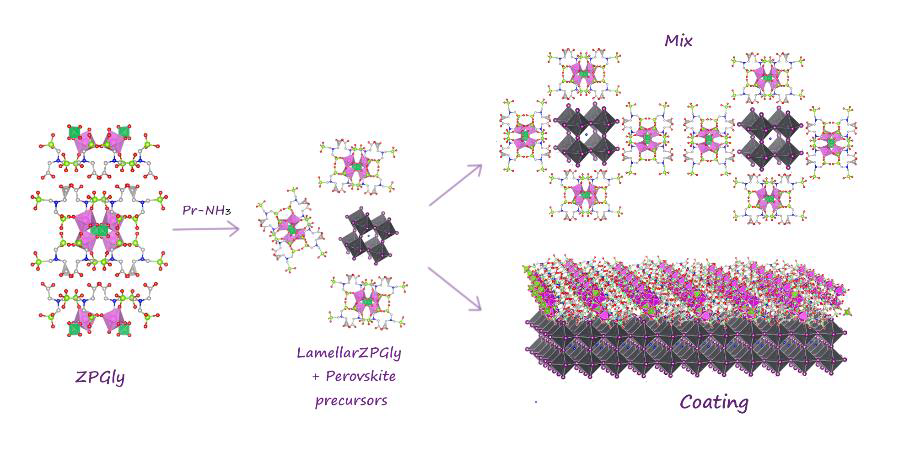Lamellar Zirconium Phosphate-Phosphonate/Perovskite composite for improved solar cell stability and efficiency
Diletta Morelli Venturi¹, Nadir Vanni¹, Giulia Quaglia¹, Elena Cambiotti¹, Eros Radicchi¹, Loredana Latterini¹, Filippo De Angelis¹,²,³; Ferdinando Costantino¹
¹Department of Chemistry, Biology and Biotechnology, University of Perugia, 06123 Perugia, Italy;
²Computational Laboratory for Hybrid/Organic Photovoltaics (CLHYO), Istituto CNR di Scienze e Tecnologie Chimiche “Giulio Natta” (CNR-SCITEC), 06123 Perugia, Italy;
³CompuNet, Istituto Italiano di Tecnologia, 16163 Genova, Italy.
diletta.morelliventuri@studenti.unipg.it
In the last ten years, PSC have attracted much attention and right now appear to have a very good chance of contributing to large scale solar energy production¹, due to the high efficiency and their low cost and quite easier preparation process.² On the other hand the stability and lifetime are major drawbacks to be launched on the market.³
Different methods are reported in literature to enhance the stability of the perovskite absorbing layer, one of this is through encapsulation that can create protective layer (against oxygen, moisture, UV-light) and the choice of the coating agent is crucial. Layered Zirconium phosphate–phosphonate could be a good option as coating agent for the perovskite encapsulation due to the possibility to obtain single layer of few nanometers thickness.⁴
In this communication we will present the result obtained by the incorporation of perovskite with a zirconium phosphonate based on glyphosine (ZPGly), having a layered structure and exposing carboxylic and phosphonic groups on the layer surface. It can be obtained as gel upon exfoliation in amine solution and used as coating agent. ZPGly was employed as coating gel covering the perovskite or used in a mixture with the perovskite nanocrystals. After that, several stability tests were conducted towards factors that are known for being harmful to perovskites, in order to test the protection that ZPGly could give; systems are tested before and after a fast aging in terms of temperature, UV irradiations, relative humidity and stability in presence of electrolyte I⁻/I₃⁻. Preliminary results on solar cell efficiency will be also reported.

Figure Schematic representation of work steps.
¹ Cells. RSC Adv. 2014, 4 (82), 43286–43314. https://doi.org/10.1039/c4ra07064j.
² J. Nanomater. 2018, 2018. https://doi.org/10.1155/2018/8148072.
³ Chem. Soc. Rev. 2020, 49 (22), 8235–8286. https://doi.org/10.1039/d0cs00573h.a
⁴ Chem. Commun. 2015, 51 (88), 15990–15993. https://doi.org/10.1039/c5cc06292f
